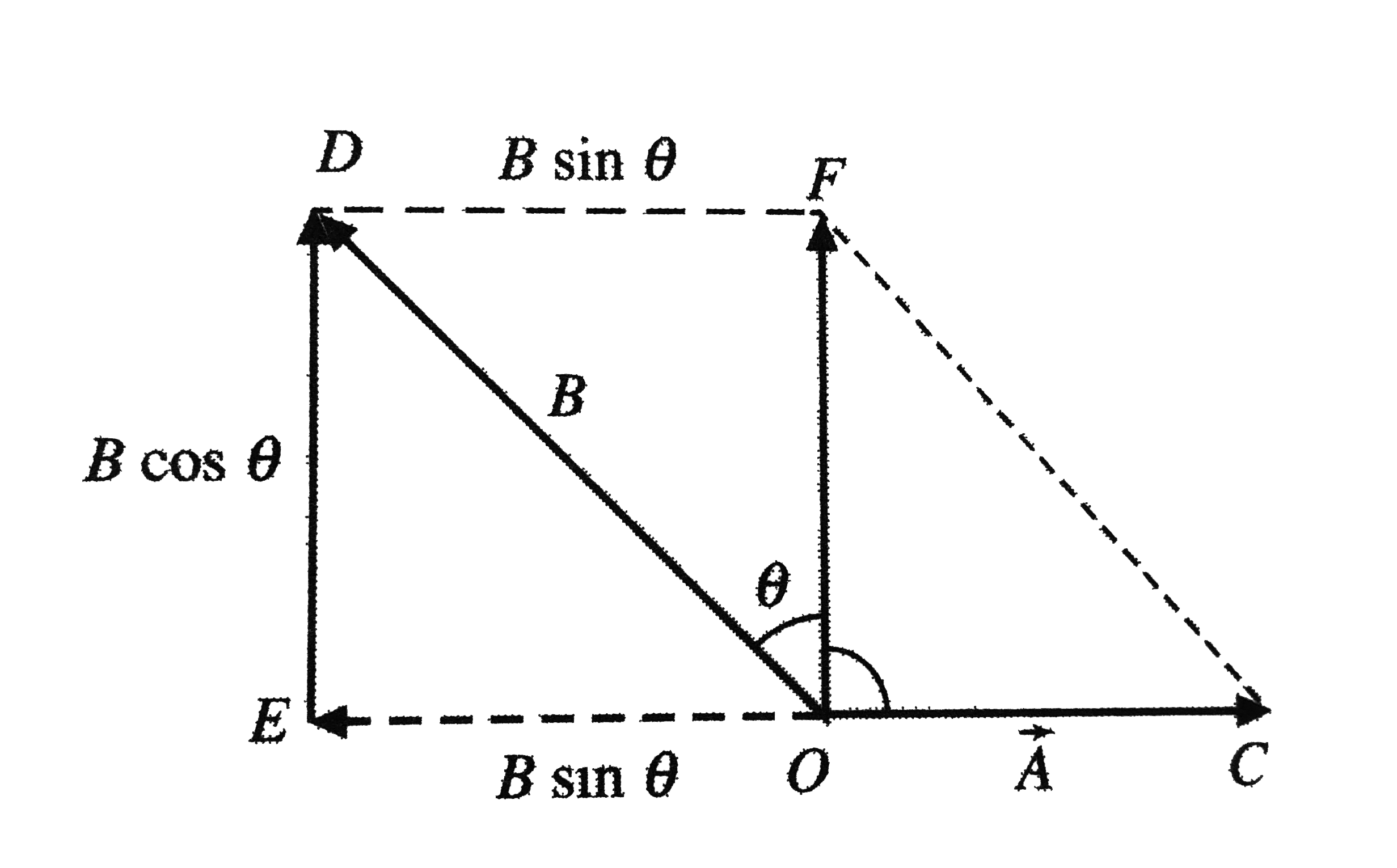When is the magnitude of (→A+→B) equal to the magnitude of (→A−→B) ?
To determine when the magnitude of →A+→B is equal to the magnitude of →A−→B, we can follow these steps:
Step 1: Write the expressions for the magnitudes
The magnitude of the vector sum →A+→B is given by:
|→A+→B|=√|→A|2+|→B|2+2|→A||→B|cosθ
where |→A| and |→B| are the magnitudes of vectors →A and →B, respectively, and θ is the angle between them.
The magnitude of the vector difference →A−→B is given by:
|→A−→B|=√|→A|2+|→B|2−2|→A||→B|cosθ
Step 2: Set the magnitudes equal to each other
We want to find when:
|→A+→B|=|→A−→B|
This gives us the equation:
√|→A|2+|→B|2+2|→A||→B|cosθ=√|→A|2+|→B|2−2|→A||→B|cosθ
Step 3: Square both sides to eliminate the square roots
Squaring both sides results in:
|→A|2+|→B|2+2|→A||→B|cosθ=|→A|2+|→B|2−2|→A||→B|cosθ
Step 4: Simplify the equation
Subtract |→A|2+|→B|2 from both sides:
2|→A||→B|cosθ=−2|→A||→B|cosθ
Adding 2|→A||→B|cosθ to both sides gives:
4|→A||→B|cosθ=0
Step 5: Solve for cosθ
This equation implies that:
cosθ=0
Step 6: Determine the angle θ
The solution cosθ=0 occurs when:
θ=90∘
Conclusion
The magnitudes of →A+→B and →A−→B are equal when the angle between the two vectors is 90∘, meaning the vectors are perpendicular to each other.
---
The magnitude of the vector sum →A+→B is given by:
|→A+→B|=√|→A|2+|→B|2+2|→A||→B|cosθ
where |→A| and |→B| are the magnitudes of vectors →A and →B, respectively, and θ is the angle between them.
|→A−→B|=√|→A|2+|→B|2−2|→A||→B|cosθ
We want to find when:
|→A+→B|=|→A−→B|
This gives us the equation:
√|→A|2+|→B|2+2|→A||→B|cosθ=√|→A|2+|→B|2−2|→A||→B|cosθ
Squaring both sides results in:
|→A|2+|→B|2+2|→A||→B|cosθ=|→A|2+|→B|2−2|→A||→B|cosθ
Subtract |→A|2+|→B|2 from both sides:
2|→A||→B|cosθ=−2|→A||→B|cosθ
Adding 2|→A||→B|cosθ to both sides gives:
4|→A||→B|cosθ=0
This equation implies that:
cosθ=0
The solution cosθ=0 occurs when:
θ=90∘
The magnitudes of →A+→B and →A−→B are equal when the angle between the two vectors is 90∘, meaning the vectors are perpendicular to each other.
Topper's Solved these Questions
- BOOK - CBSE COMPLEMENTARY MATERIALCHAPTER - KINEMATICSEXERCISE - 2 Marks14videos
KINEMATICS
- BOOK - CBSE COMPLEMENTARY MATERIALCHAPTER - KINEMATICSEXERCISE - 3 Marks11videos
KINEMATICS
- BOOK - CBSE COMPLEMENTARY MATERIALCHAPTER - GRAVITATIONEXERCISE - MULTIPLE CHOICE QUESTIONS19videos
GRAVITATION
- BOOK - CBSE COMPLEMENTARY MATERIALCHAPTER - KINETIC THEORY OF GASESEXERCISE - Objective question20videos
KINETIC THEORY OF GASES
Similar Questions
Knowledge Check
- Question 1 - Select One
Two vectors →A and →B have equal magnitudes. If magnitude of →A+→B is equal to n times the magnitude of →A−→B, then the angle between →A and →B is :-
Acos−1(n−1n+1)Bcos−1(n2−1n2+1)Csin−1(n−1n+1)Dsin−1(n2−1n3+1) - Question 2 - Select One
If →A+→B=→C, then magnitude of →B is
A→C−→ABC-AC√→C.→B−→A.→BD√→C.→A−→B.→A - Question 3 - Select One
The resultant of two vectors →A and →B is perpendicular to the vector →A and its magnitude is equal to half of the magnitude of the vector →B. Find out the angles between →A and →B.
 .A120B90C60D150
.A120B90C60D150
If →Aand →B have angle between them equals to 60∘ and their resultant make, angle 45∘ with →Aand→A have magnitude equal to 10. Then Find magnitude of →B.
View SolutionIf two vectors →Aand →Bmake angle 30∘and45∘ with their resultant and →B has magnitude equal to 10, then find magnitude of →A.
View SolutionThe resultant of two vectors →A and →B is perpendicular to →A and equal to half of the magnitud of →B. Find angle between →B and →B?
View SolutionThe resultant of the vectors A and B is perpendicular to the vector A and its magnitude is equal to half the magnitude of vector B. The angle between →A and →B is :-
View SolutionTwo vectors →A and →B have magnitude in the ratio 1:2 respectively. Their difference vector has as magnitude of 10 units, and the angle between →A&→B is 120∘ . The magnitude of →Aand→B are :
View Solution

